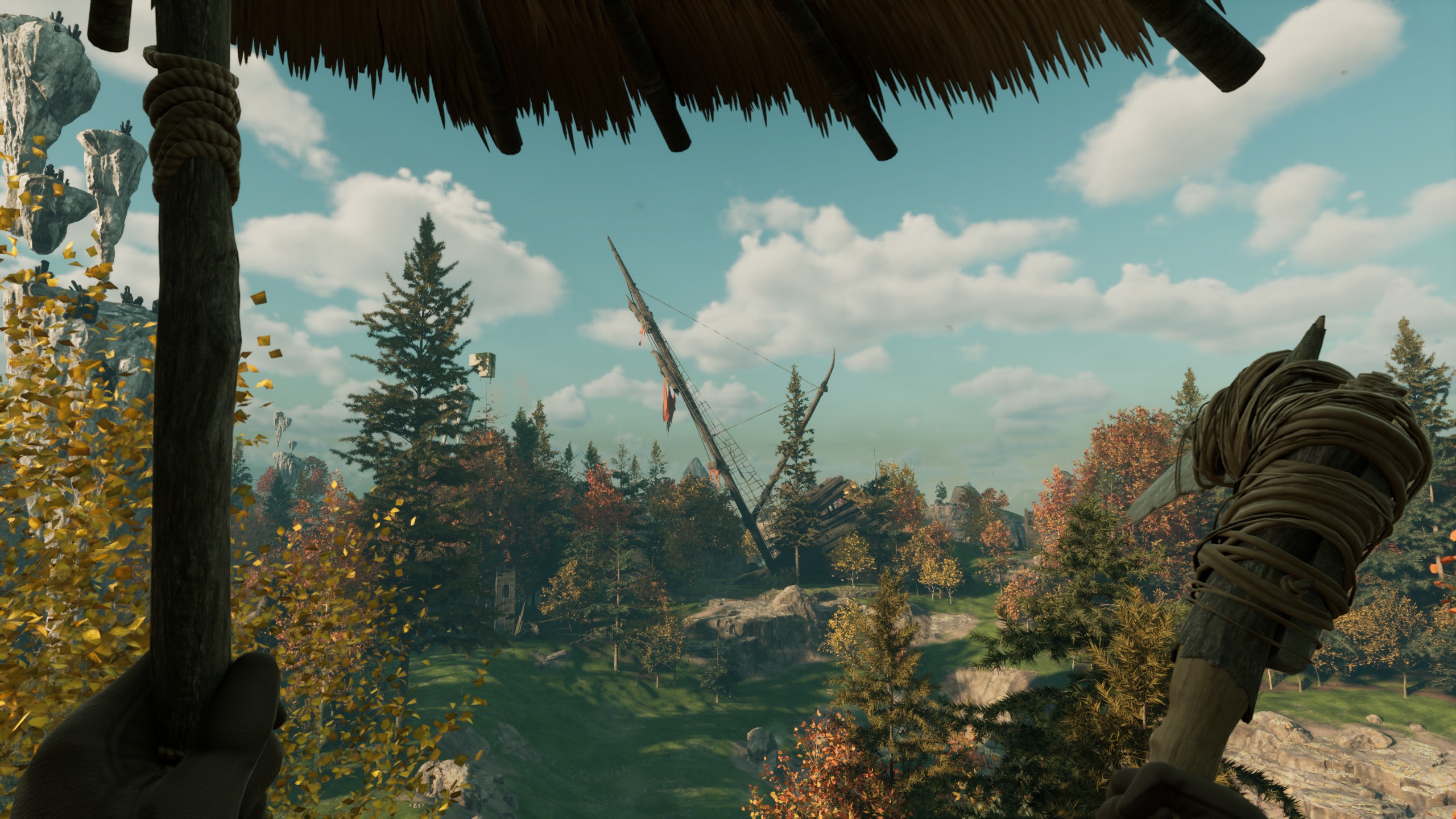Games and umbrellas don’t usually collide, but I’ve thought more about umbrellas in the last few days than I have in my entire life. It all began when I found one inside a chest in Nightingale’s tutorial area, though I only discovered how useful it could be much later. This kind of sums up Nightingale, which launches on Steam early access next week. Let me expand.
As soon as I entered the game, my survival muscle memory kicked in and I immediately started hunting for sticks and stones, and anything else I could pick up, without any real knowledge of what I’d need it for, but knowing that I would. As far as basic survival mechanics go, Nightingale isn’t breaking the mould—and it took me a little while to discover and then appreciate what it is going for.
Nightingale is a survival game with a twist. It’s set in an alternate universe Victorian era where the Fae and their magic are part of our world and, thanks to them, Realmwalkers have learned to create portals to explore other lands. Victorian-era machinery or out-of-place contraptions litter the landscape of the realms you visit. You never know what you might find around the next tree or hillside. You’re just as likely to see an old Penny Farthing bicycle rusting at the base of a tree, as you are a berry bush or a pile of sticks.
Your umbrella might seem out of place as a tool for survival at first, but you’ll soon learn that it lets you glide for short distances and shelters you from the worst of the elements. Not to mention it makes you look pretty snazzy. I mean, what Victorian gentleman—or lady—would be seen out and about without one? Except, you’re not in Victorian London, you’re trying to survive in the wilds. So what happened?
Just before the game opens, the Pale, the space you travel through between portals, becomes unstable and surrounds the Earth, freezing it. Some Realmwalkers were able to open portals and escape but were transported to unknown and faraway realms, which leads us to one of the unique mechanics of Nightingale: Realm Cards.
On the cards
(Image credit: Inflexion Games)
Realm Cards are one of the requirements for opening a portal to a new realm, and they give you some control over what you can expect when you get there. You need two cards to open a portal: a Biome Card determines whether it’s a forest, desert or swamp, and a Major Card tells the resulting realm which parameters it should abide by, including points of interest, NPCs and quests.
The first portal I made after the tutorial uses the “Abeyance” Major Card. This card creates a realm that’s safe enough to create your base and get to grips with the mechanics of the game before experimenting with other, more dangerous card combinations. It’s also the place you’ll call your home and you’ll be able to fast travel back to it from other realms whenever you wish.
Each realm you create is procedurally generated so no two players will get the same result from the same card combination. The biome and the parameters will be the same, but the map will be different.
Then there are Minor Cards, which are optional. Every realm has a Realmic Transmuter which you’ll need to locate if you want to activate one of these. Minor Cards change the rules that govern the realm and generally have a pro and a con, though not always. The Might Card increases your strength and carrying capacity, for example, but the durability of tools and gear decays more quickly. Only one Minor card can be active at a time and you can switch them out whenever you want.
I’ve already seen how useful these Minor cards can be: during the preview, I was searching for a quest objective which wasn’t marked on the map, so I had a lot of ground to cover to locate it. Activating a card that increased my travel speed was invaluable for covering ground quickly. It wasn’t necessary, but it certainly made this particular quest much easier.
Finding your roots
(Image credit: Inflexion Games)
Before you can start exploring card effects or create portals, you’ll need to make your realmwalker. The character creation goes into a surprising amount of detail. Not only can you choose your character’s origin story, but you also get to pick their lineage, including specific grandparents and great-grandparents going back a couple of generations. This seems to influence your base appearance, though you can go on to edit your character in more detail afterwards.
The characters themselves are stylised and aren’t meant to be photo-realistic but more importantly, the clothes look good. You’ll get no complaints from me over not being able to make out individual eyebrow hairs—just as long as my outfit and umbrella look suitably fancy, I’m more than happy.
It’s also worth noting that you can switch between first and third-person controls with one keystroke, and screenshot enthusiasts can join me in rejoicing at the inclusion of a UI toggle—may your screenshots be crispy and clear!
Work-in-progress
While Nightingale’s progression is more quest-related than other survival games I’ve played recently, the core system is the same. You know the drill—collect increasingly rarer resources and materials to craft better tools and weapons, and on it goes. You’ll also need to monitor your hunger and exhaustion levels like traditional survival games, but this isn’t as tedious as it might sound.
Basic food is plentiful and I never had any concerns about running out and going hungry. Exhaustion is easy enough to fix too, because you can whip up a bedroll with a few basic materials and place it pretty much anywhere. You don’t even need to put it under cover, though your rest won’t be quite as invigorating as it would be if it were somewhere warm and cosy. You can even rest mid-fight if you’re able to distract whatever’s hitting you long enough to place and interact with a bedroll. It’s not the most refreshing rest you’ll ever get—or the most dignified—but it’s better than running out of stamina completely.
The creatures you see aren’t always your normal run-of-the-mill survival fare either. Sure, you can find deer and boars to hunt, but you’ll also see little oddly-shaped automated workers hovering around some realms, like metallic pawns from a chessboard. And while they aren’t aggressive unless you attack them first, there’s something oddly disturbing about the way they move around carrying out their tasks, like they have some kind of eerie intelligence they have no business possessing.
(Image credit: Inflexion Games)
If you do get into a fight with them, combat feels nice and responsive. Depending on your weapon, you can dodge or block attacks. You start off with a fairly rudimentary arsenal, though you’ll gain access to firearms, different types of ammo, and more powerful melee weapons as you progress. And of course, your umbrella can be handy for making a quick getaway. There’s nothing wrong with high-tailing it out of danger and over a cliff edge if needs be, so you can glide to fight another day.
Certain NPCs can be recruited as companions to lend you a hand, too. If you equip them with a wood axe, they’ll follow you around and chop down any trees that are close by, and you can switch out their tool to suit your needs. They’ll also help you fight if you’re attacked and will even revive you if you take on one too many enemies or, uh, misjudge the difficulty of a boss.
Currently, you aren’t able to assign tasks to companions so you can’t leave them at your base. Having them following you around constantly while exploring can get pretty annoying, but I’ve been assured that more options for these helpful NPCs will be coming in a future update. That said, I’d still take them along to any combat situations, just because they’re useful if you need to be revived.
The more the merrier
(Image credit: Inflexion Games)
I didn’t get to do much base building during my time with the Nightingale preview, aside from a rickety tent to keep off the worst of the weather, but I did get to see what was possible when visiting one of the Inflexion devs on their own realm during a co-op session.
You can make buildings from wood or stone, and have them in various styles, and sizes. Complex, multi-storied homes are perfectly viable, as are more simple huts meant to be more functional than fancy. There’s nothing stopping you from building wherever you want either. If you want an estate that sprawls halfway across your realm, and you have the resources—and motivation—to get it done, you can.
You can play Nightingale with up to six friends, though everything in the game can be done solo or as part of a group so it’s up to you how you decide to play. There are Vaults to explore, which are basically dungeons with a mixture of enemies and puzzles to overcome, generally with a boss at the end. And you can always try your hand at taking down an Apex creature, providing you have a Hunt Major card to create a realm that contains one.
If you do decide to party up with friends though, you can invite them to your realm or you can go to theirs. And if you really trust them, you’ll eventually be able to craft an Estate card, which gives them access to your Abeyance—or home—realm even when you’re not online.
Personally, I’m going to hole up in my Abeyance realm and build the most glorious base imaginable—or that available materials allow—before I start venturing too far into more dangerous adventures.
Whatever you decide to do, just make sure you’re prepared before you set out. Don’t do what my co-op group did and pull creatures from half the zone on the way to the Apex enemy or you’ll end up fighting them all at the same time. Not the best idea for your health, though it’s pretty handy if you want to test out the sprint key and/or test how fast you are at reviving people.
(Image credit: Inflexion Games)
Nightingale launches in early access on February 20th and I expected a lot of bugs, but I came across little that flagged the game as a work-in-progress. Aside from the default keybinds for the hotbar feeling a little fiddly, and some missing icons on items in my inventory, nothing really stood out as problematic.
I’m eager to jump into the game properly and learn more about the story. I want to explore different realms and find more random stuff in unexpected places. Like the mast of a huge ship, attached to half a boat, seemingly sinking in the middle of a forested area. I also want to get back to my umbrella, so I can glide around the countryside like a tooled-up Mary Poppins, while I scope out sites for my base: which will be practically perfect in every way.











